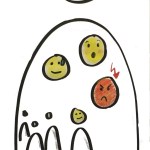A short while ago I introduced the inner team and how it can support introspection and self-leadership in difficult and ambiguous situations. Today I would like to go through an example with you on how that can work for leaders.
Working with the following scenario, that may ring familiar in the current situation (this is purely fictional, as my coaching sessions are fully confidential):
- The product owner in a medium-sized company with 60 employees, who is responsible for the business’ main income earning product, has requested coaching.
- At the same time as being responsible for one product, they run a small team of product owners, who are involved in other product lines throughout the company and consult with them on ways of working, amongst other things.
- The customer for their product is suffering income losses due to the pandemic and has requested a meeting, in order to discuss how to proceed.
- They have an idea that a delay may be requested and are aware that the team working on this product – about 20 full-time employees – will be affected by any delay, as well as this impacting the company’s bottom line.
We will be looking at how this tool can be useful in leadership coaching.
Without wanting to assign a particular solution for this situation, as solutions tend to be particular to each coaching situation.
So, we will now use the inner team as a tool to separate out what might be going on in the product owner’s own experience.
Let’s say the product owner has access to business coaching through their company and has arranged to talk to me as their business coach.
The product owner came into the coaching order to get some clarity on what he could do quickly, as this is a pressing matter and talk with the customer is the following day.
First of all, we determine that the inner team is a tool worth using here that will help them achieve their goal.
The second step, which is what this article is addressing, is to look at what inner team members are affecting their considerations at the moment.
What we found is the following:
-
The inner product hero:
- Possibly triggered by the part of the situation that is concerned with their product and the part of the product owner that is very proud of what they do and the product they are responsible for. The hero considers it her job (the gender of each of these parts is, for this example, assigned at random, but will be determined by the coachee in question) to drive the product forward. Concerns here may have to do with a stall in development and focus on the product, a reduction in status in the company while it is on hold, amongst other things.
-
The inner gardener:
- This may be triggered in relation to the product owner’s responsibility for their team of product owners, as well as in relation to the development team they work with. They are only disciplinarily responsible for one of them, but clearly like to work with people, and are concerned that a reduction in income for the company may affect what they can invest into their product owner team. They may also be concerned how to keep the development team’s feeling of community during the break, plus worrying how they will get access to the their resources if they are re-deployed to other projects during the break in their product.
-
The inner investigator:
- Possibly triggered by the knowledge that the customer wants to reduce resources on their product, the inner part of the investigator may already be investigating potential solutions for that. It may be developing interim plans in order to keep a small crew on the product, and what to do when the customer wants to return to full focus. It will be thinking about the fact that the development team will want to contribute to the company success in other ways while the project is on hold, and thinking of possible solutions to that too.
-
The inner worrier:
- This inner part is fairly common in complex situations involving responsibility for people and products. Sometimes leaders can locate it in the stomach area, sometimes in the shoulders, everyone’s is different. This inner part is mostly triggered by the uncertainty of the situation. It is concerned with the future, and the ‘what ifs’ of what could happen…. In many cases, it tends to focus on the negative outcomes but can be re-directed if addressed.
So there’s our example inner team in a leadership role. It is by no means exhaustive, but gives a you an introduction and demonstration of how the inner team can support detangling complex situations. In coaching sessions these findings are then used to develop good, sustainable solutions towards the individual coachee’s goal.
Coaching with this tool brings with it the benefit of identifying said inner team players, and then finding ways to handle and manage the team. If you are struggling with complex situations at the moment and could use some support, get in touch! I am looking forward to hearing from you.





